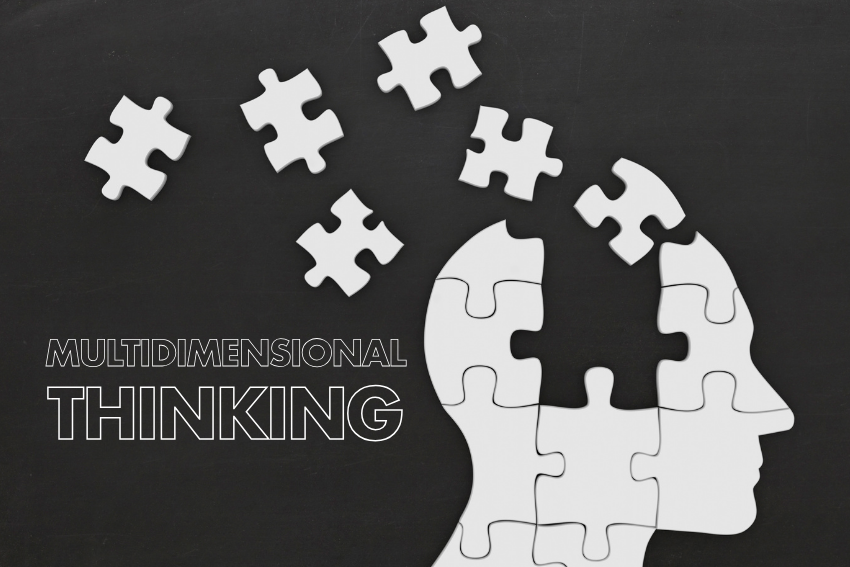Introduction to Multidimensional Thinking
Ever wondered why some people are able to see opportunities and solutions that others cannot? How do they connect unrelated ideas to tackle complex challenges? Often, the solution is found in something referred to as multidimensional thinking. Thanks to this kind of thinking, humans can easily go beyond a linear or reductionist way of thinking; in other words, humans can have the ability to analyze matters from a multidimensional perspective, create balances, and make decisions in the light of multidimensional considerations.

This is because information is readily available in current society, but it is not so easy to obtain the actual knowledge needed to make decisions. This can prove essential for business people, students, creative workers, or anyone who wants to enhance their problem-solving skills. Multidimensional thinking brings new dimensions and involves multiple purposeful perspectives.
In this guide, I will share with you the fundamentals of getting started in multidimensional thinking, why it is an excellent practice to adopt, and how you can apply it effectively.
What is Multidimensional Thinking?
Multidimensional thinking is the ability to consider multiple perspectives, variables and potential outcomes simultaneously. To some extent it is like a roadmap and using it you can easily find certain links that are not always visible and cover all possible outcomes.
This approach is different from linear thinking, where ideas and processes are viewed in a straightforward, step-by-step sequence. Linear thinking can be valuable for simple, process-based tasks. But when things get complex, linear thinking alone falls short. On the other hand, multidimensional thinking opens up wider possibilities, enables a deeper understanding of complex issues and promotes creative solutions.
Imagine a business challenge. A linear thinker might focus on financial metrics alone. Meanwhile, a multidimensional thinker will consider not just finances but also factors such as customer satisfaction, brand impact, employee morale and long-term growth. This broader approach often leads to more sustainable, innovative solutions.
The Importance of Multidimensional Thinking
Adaptability in Complex Situations
Today’s world is fast paced, interconnected, and often uncertain. Complex problems require more than single factor analysis or traditional methods. Multidisciplinary thinkers perform better here. They are able to adapt to rapidly changing environments, taking into account social, economic, emotional, and other considerations.
Consider a global supply chain issue. A multidisciplinary thinker doesn’t just focus on logistics. It will also cover matters of international policies, currency exchange rates, labor markets, and even political instability. With this kind of thinking structure, making decisions even on the basis of partial or emerging information can be effective, for the needs of the individuals and organizations that have to make these decisions.
Enhanced Problem-Solving Abilities
The other essential area that benefits greatly from multidimensional thinking is problem-solving. When you look at issues from different perspectives, it is easier to solve problems intelligently. By learning to look beyond the superficial level of problem solving, it is possible to solve root causes, anticipate difficulties, and conceptualize in new ways.
Take a software development team working to improve user engagement. A team using multidimensional thinking will analyze user behavior patterns, feedback loops, technical optimizations, and even social psychology. This multidimensional approach allows them to create solutions that resonate on multiple levels, making the chances of success much higher.
Boosted Creativity
With multidimensional thinking, creativity gets a major boost. When people look at things in a different light, and use new approaches with them, they free themselves from the usual boundaries. Such kinds of thinking promote creativity and more so out of the box solutions.
It is always important to encourage different approaches to doing things. There were quite a few inventions and masterpieces coming from the interdisciplinary thinking of the creators. While it is possible to use art to depict the logic, the result might look quite different if a scientist enamored with art started contemplating scientific theories, or an artist brought to physics, for instance.
Core Components of Multidimensional Thinking
To think multidimensionally, it helps to understand its core components:
Lateral Thinking
Lateral thinking involves approaching problems from unconventional perspectives, making it an essential part of multidimensional thinking. Instead of following predictable paths, lateral thinkers seek alternative routes, often leading to surprising insights.
For example, if someone wanted to boost workplace productivity, a lateral thinker might go beyond traditional methods. They’d explore things like changing the office environment, introducing wellness initiatives, or even gamifying tasks to engage employees.
Systems Thinking
Systems thinking in the broad perspective of the complex system and is all about how the elements in this system work. In contrast with the reductionistic approach, systems thinkers consider the relations and loops that may be out of sight.
Picture a community facing environmental challenges. A systems thinker would examine how local businesses, government policies, and citizens’ behaviors all contribute. By spotting these interdependencies, they can identify more comprehensive, sustainable solutions.
Perspective-Taking
Perspective-taking is the ability to consider viewpoints other than your own. I found this skill to be helpful with any kind of multidimensional approach. Regarding others’ ideas, thinkers predict how various people approach a given problem and thus make decisions based on their comprehension of others.
Imagine a manager resolving a workplace conflict. By considering each employee’s perspective, understanding their motivations, and finding common ground, they reach solutions that respect all parties and foster a more harmonious environment.
Integrative Thinking
Integrative thinking is the art of combining elements from different fields or ideas to create new solutions. This often means waging together two opposites or finding the middle ground between two values which are typical tasks for multidimensional minds.
In business for example, integrative thinking could refer to consideration of business profit motives and the potential effects on society. Those who perform well in this area gain competitive advantage and colorful cash flows besides providing societal benefit, meaning that unity is strength than conflict.
How to Develop Multidimensional Thinking Skills
Building multidimensional thinking takes time and practice, but with consistent effort, anyone can develop this skill. Here’s how to get started:
Step 1: Practice Breaking Down Complex Problems
Start with a complex problem in your life or work. Write down all the factors involved—big or small. Then, look for patterns, dependencies, or overlooked aspects. This exercise helps you practice seeing a problem rather than in isolated pieces.
Step 2: Explore Different Perspectives
Perform tasks that will force you to look at issues from a different perspective. You may name it a debate where you discuss a topic with arguments that are on the opposite poles, or a different culture, where you study more about other people’s perspectives, or even simple exercises where your open-mindedness is being checked. It may be an only because to talk with people from different perspective about a single topic can open your mind and expand ideas.
Step 3: Strengthen Analytical and Creative Skills
Multidimensional thinking requires both analytical and creative skills. Create these by making them a balanced combination of problem-solving exercises and creative tasks such as brainstorming, puzzles, mind maps and more. By challenging yourself in both areas, you’ll learn to apply multidimensional thinking in a balanced way.
Step 4: Study Real-World Systems
Practice your multidimensional thinking by analyzing real-world systems. Watch an ecosystem, business, or a sports team and define what makes it work. Determining how components relate with one another and considering the impacts of changing components on another.
Examples of Multidimensional Thinking in Action
To see multidimensional thinking in action, let’s look at a few real-world examples where this skill made a significant impact.
Example 1: Strategic Decision-Making in Leadership
Great leaders often excel at multidimensional thinking. They don’t just focus on financial outcomes—they consider impacts on employees, customers, and the wider community. This approach helps them make decisions that balance profit with purpose, guiding their organizations toward sustainable success.
Example 2: Scientific Problem-Solving
Scientists tackling complex challenges, like climate change, use multidimensional thinking. They look at everything from atmospheric science to social behavior, policy, and technology, recognizing that no single solution will work. By viewing the problem from multiple dimensions, they’re able to craft effective, long-term strategies.
Example 3: Personal Growth and Social Dynamics
In personal life, multidimensional thinking can improve relationships and personal development. For instance, when we learn each of the employees and other people we deal with is motivated by some values at the emotional level, there are improved relations. It also makes it easier to deal with social interactions as you focus in on how people work and think.
Benefits of Multidimensional Thinking
The effects of multidimensional thinking extend beyond problem-solving and creativity, enhancing various aspects of life:
Adaptability and Flexibility
Multidimensional thinkers thus have pluralistic orientations, predisposed to seeing more than one way or answer. They are more equipped to balance themselves for an unpredictable change because their mind is conditioned to look for other possible scenarios.
Improved Decision-Making
It makes much better sense to analyze all aspects of a case. Through considering different parameters, multidimensional individuals can protect themselves from making hasty decisions that have severe consequences shortly afterward; thus, the end results are normally better than expected, as more focus is paid to the distant consequences.
Growth in Emotional Intelligence
Perspective-taking, a core element of multidimensional thinking, fosters empathy. This increase in EI aids multidimensional thinkers to perform in social contexts and to develop interpersonal network of healthy interacting relationships in personal and job world.
Conclusion
Multidimensional thinking is a powerful skill that opens new ways of understanding, solving, and creating. To this end, it allows you to solve multifaceted problems, manage the context in which you operate, and identify potentialities beyond the sight of those around you.
To start, anyone can look at examples from the real world, engage in role-taking and analyze problems into its components. Over time, you’ll strengthen your multidimensional thinking skills, preparing yourself for the complexities and surprises of life and work.
Why not start today? Step into the world of multidimensional thinking and begin seeing the bigger picture in every situation.





